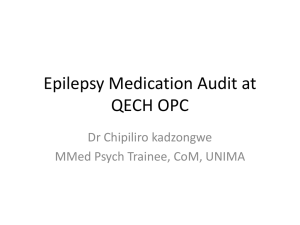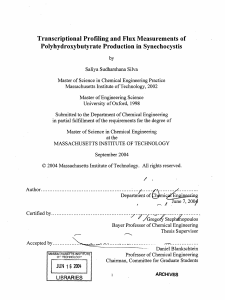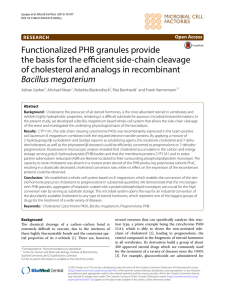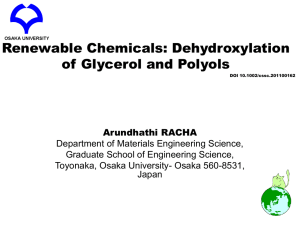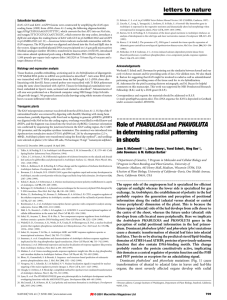The PHB case using Bacillus megaterium
advertisement
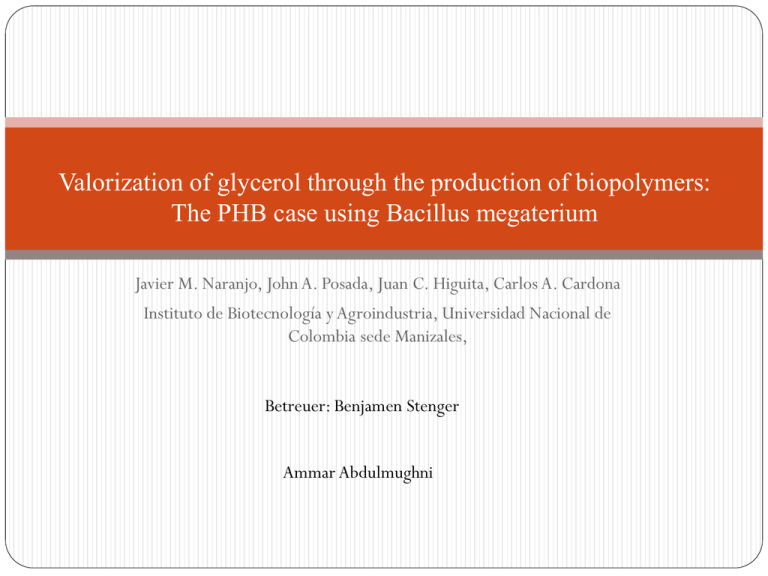
Valorization of glycerol through the production of biopolymers: The PHB case using Bacillus megaterium Javier M. Naranjo, John A. Posada, Juan C. Higuita, Carlos A. Cardona Instituto de Biotecnología y Agroindustria, Universidad Nacional de Colombia sede Manizales, Betreuer: Benjamen Stenger Ammar Abdulmughni Overview Introduction Polyhydroxyakanoate (PHA): Structure, Biosynthesis Production Aim of this subject Results Summary Polyhydroxyakanoate (PHA) PHAs are linear polyesters Many prokaryotes can synthesize and store PHAs in form of granules (up to 80 % of total bacterial weight) PHAs have similar mechanical properties to conventional plastics They are generally biodegradable Polyhydroxyakanoate (PHA) The biosynthesis of PHA : certain deficiency conditions and excess supply of carbon sources The most common/produced form of PHA is polyhydroxybutyrate, PHB Like polypropylene or polyethylene. PHB Biosynthesis of PHB PHB Production Production costs are heigh: PHB accumulate intercellularly: - Use of a solvent - thermal treatment of biomass, enzymatic digestion and washing with an surfactant a self-disruptive strain. The lysis system of Bacillus amyloliquefaciens phage was inserted into shuttle vector The expression of a target gene is inhibited by glucose When the glucose concentration approached zero, self-disruption is induced PHB Production Production costs are heigh: carbon sources The carbon source could account for 25–45% of the total production costs Cheaper carbon sources PHB Production Agroindustrial wastes are attractive candidates as substrates: low prices and heigh availability solving an environmental problem A variety of microorganisms are able to produce PHB from diverse agroindustrial wastes: Methylobacterium rhodesianum (Borman et al., 1999) Cupriavidus necator (Cavalheiro et al., 2009) E. coli CT1061 (Nikel et al., 2008) Glycerol is carbon source Crude glycerol is a co-product in the production of biodiesel Glycerol is an important industrial feedstock : - food, drugs, cosmetics, pharmaceuticals, textile and tobacco industries Glycerol can be used as carbon source in microbiological processes Polyhydroxyakanoate (PHA) production is an interesting biological transformation of glycerol. PHB Production Currently, PHB is produced at an industrial scale using Gram negative bacteria lipopolysaccharides (LPS) which co-purify with the PHAs and induce a strong immunogenic reaction (Valappil et al., 2007) Bacillus megaterium Aim Techno-economic analysis of PHB production: - Glycerol transformation into PHB (using Bacillus megaterium) - Glycerol or Glucose as substrate - Productivity at different conditions Results Different initial concentration of glycerol Biomass PHB Production The fermentation conditions: temperature 30 °C, air flow 12 l/min and uncontrolled pH Results Different temperatures of fermentation Biomass PHB Production The fermentation conditions: initial glycerol concentration of 20 g/l, air flow 12 l/min, and uncontrolled pH Results PHB production using glucose or glycerol Very Similar yields Results Batch cultivation: The fermentations to produce PHB were carried out for 42 h in a 3.7 l Lab Fermen Results Economic analysis: The current sale prices are between 3.1 and 4.4 USD/kg Summary PHAs are linear polyesters and can be synthesized and itnracellularly stored by many prokaryotes. The most produced form of PHA is PHB PHAs have similar mechanical properties to conventional plastics Production costs are heigh PHB Production using B. megaterium, and glycerol as carbon source The results confirm the ability of B. megaterium to use glycerol as the only carbon source. References Valorization of glycerol through the production of biopolymers: The PHB case using Bacillus megaterium, Javier M. Naranjo, John A. Posada, Juan C. Higuita, Carlos A. Cardona, Bioresource Technology 133 (2013) 38–44. Polyhydroxybutyrate synthesis on biodiesel wastewater using mixed microbial consortia, Zachary T. Dobroth a, Shengjun Hub, Erik R. Coats a, Armando G. McDonaldBioresource Technology 102 (2011) 3352–3359 Large-scale production and efficient recovery of PHB with desirable material properties, from the newly characterised Bacillus cereus SPV, Valappil SP, Misra SK, Boccaccini AR, Keshavarz T, Bucke C, Roy I., J Biotechnol. 2007 Nov 1;132(3):251-8 Construction of self-disruptive Bacillus megaterium in response to substrate exhaustion for polyhydroxybutyrate production. Hori K, Kaneko M,TanjiY, Xing XH, Unno H. Graduate School of Bioscience and Biotechnology, 4259 Nagatsuta-cho, Midori-ku,Yokohama 226-8501, Japan. THANK YOU
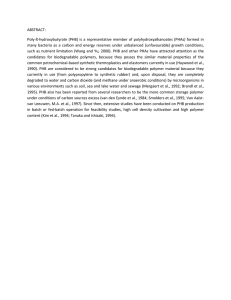
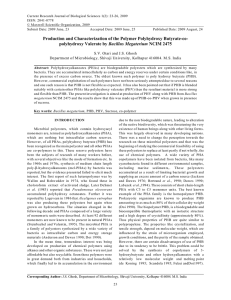
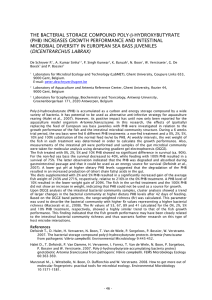
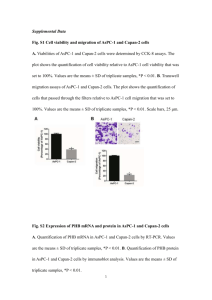
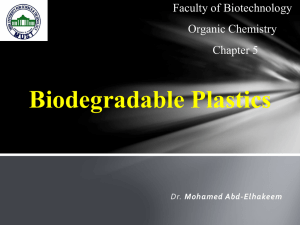
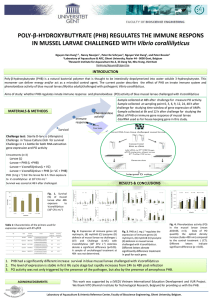
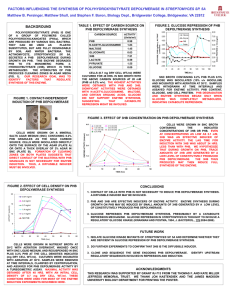
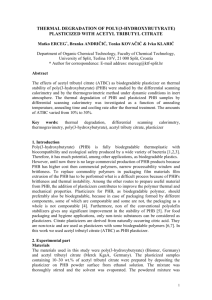
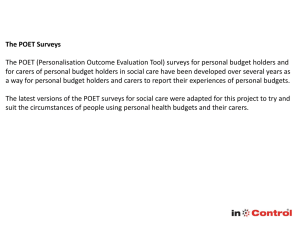
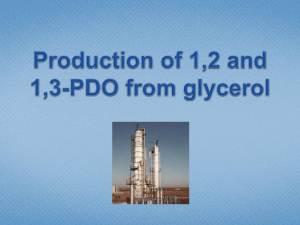
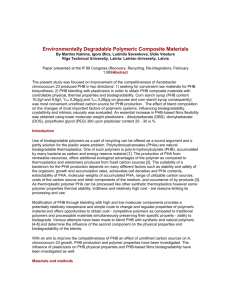
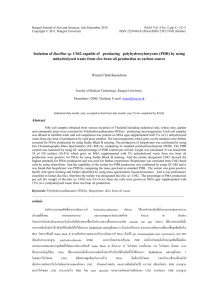

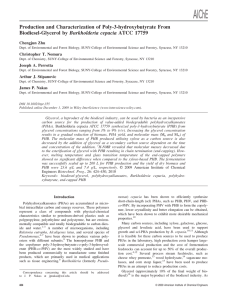

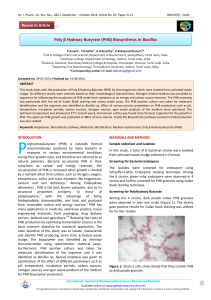
![Quality of Service [Autosaved]](http://s2.studylib.net/store/data/005612920_1-669e91c219b94acbd910775405848f1b-300x300.png)
